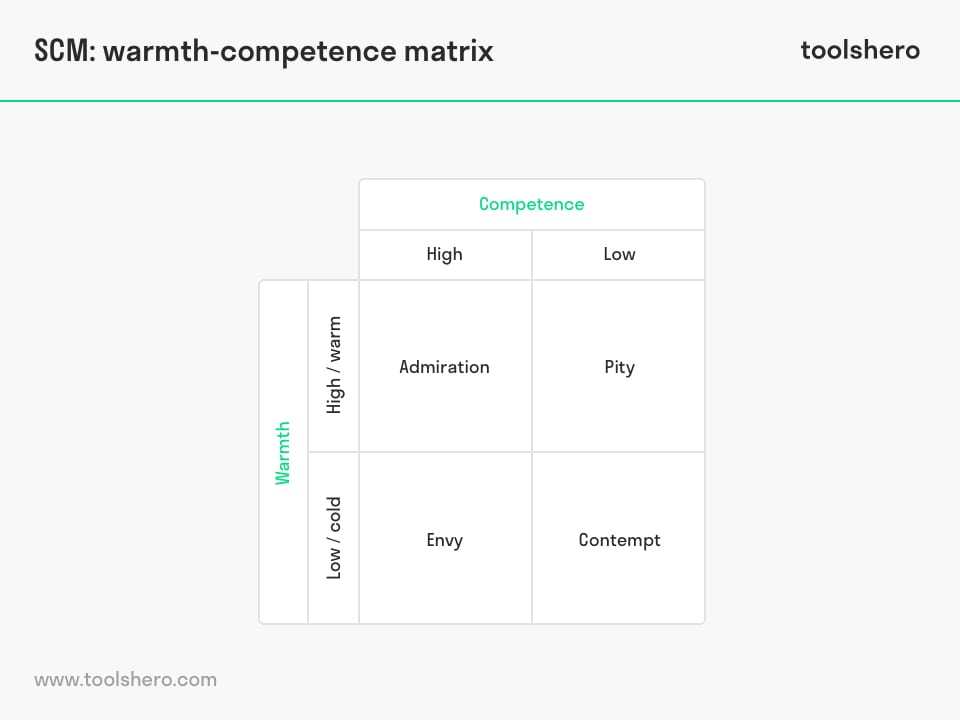Stereotype Content Model (SCM)

Stereotype Content Model (SCM): this article provides a practical explanation of the Stereotype Content Model (SCM). Highlights of this article include: the SCM definition and explanation, the two dimensions (warmth and competence) explained, the four dimension combinations (admiration, jealousy, pity, contempt) explored and a summary. Enjoy reading!
What is the Stereotype Content Model (SCM)?
Definition of the Stereotype Content Model
The Stereotype Content Model or SCM is a psychological and communication theory that suggests that group stereotypes consist of two dimensions: warmth and competence. Not all stereotypes and stereotype groups are the same.
Some are viewed as incompetent and useless, for instance elderly, whereas others are respected due to the excessive, perhaps threatening, competences they allegedly possess, such as Asians. Other stereotype groups are often viewed as sweet and harmless, like women, and some rich people are considered to be cold and indifferent.
These stereotypes are the subject of lots of research within the field of social psychology. Results of this research show that the negative stereotype, of incompetence or subordination, always coincides with the positive stereotype of warmth. The composition of this combination results in a unique collection of prejudices aimed at various groups in society and ethnic groups in general.
The Stereotype Content Model (SCM) was first proposed by social psychologist Susan Fiske and her colleagues Amy Cuddy, Peter Glick and Jun Zu in 2002.
Later experimental tests on various national and international sample studies showed that the reliability of the Stereotype Content Model (SCM) was sufficient in various cultural contexts and that it is able to predict the affective reactions of a variety of different groups. The model has also received support from fields such as interpersonal perception.

Figure 1 – Stereotype Content Model (SCM)
The Two Dimensions
Warmth and competence are the fundamental dimensions on which both individuals and groups are assessed. These two dimensions have a rich history in terms of the quantity and intensity of the research that has been conducted into this subject.
In a classic study by Asch in 1946, information about the warmth of a person was manipulated and changed, while the information about his/her competence remained the same. This resulted in a radical change in the perception of the individual.
Warmth
Warmth in this context is accompanied by the question of someone’s trustworthiness, and particularly the uttered intentions of a person towards someone else. For this reason, warmth is more important than the question of whether a person’s competence is sufficient to actually carry out these intentions.
A warm person is friendly to others, respects them and cares for them. With such warmth, they create a mutual feeling of trust and connection. On the other hand, a cold person has more trouble gaining others’ sympathy and doesn’t care much about this either.
By adopting a distant attitude, it seems as if this person deems himself to be superior, which results in others limiting their trust. In stereotyping, groups are considered to be warm or cold in different ways. For example, managers are often seen as cold and psychologists as warm. People who don’t fit within a certain group are considered to be cold more often than people within a group.
A few examples of warm characteristics are:
- Friendliness
- Reliability
- Empathy
Competence
Competence is about how capable someone is in carrying out both the good and bad perceived intentions. The judgement of this dimension is formed shortly after someone is judged in the warmth dimension.
Moderating warmth is the degree to which other people are deemed to be competent. When someone is viewed as capable, this is a reason to admire them, sometimes grudgingly so due to jealousy.
Competence is often used when forming stereotypes. An example of this is that someone may think that people in a lower social class may owe their poor circumstances to their own incompetence rather than to other factors. Competence characteristics include:
- Intelligence
- Power / strength
- Working intent
- Skill
Stereotype Content Model: dimension combinations
Warmth and competence are two separate dimensions that are conceptually orthogonal, not overlapping. Therefore, a low or high score in one of the dimensions can be combined with either a high or low score in the other dimension.
The inventors of the Stereotype Content Model (SCM) gave the result of the combination an umbrella term. The following four combinations were found:
Admiration
Both warmth and competence are considered to be pleasant factors, which makes it easier to admire people with both these aspects. Admiration is low warmth high competence on the matrix.
Competence can be seen as a gift or capability, but in general, kind people are considered to be more deserving of such skills than unkind people, who are often begrudged their talents.
Jealousy / envy
When a person seems cold and unfriendly, it seems to be a reasonable assumption that this person isn’t well loved. They are classified as ‘bad’ people, but when they are highly competent, this leads to a conflicting view of them. They are deemed to be undeserving of their capabilities, which leaves envy.
Pity
Warm people are valued and a lack of competence is therefore not considered to be a negative characteristic. The real competence of warm people is the very fact that they are good people, even though this may be difficult to see for some.
Some people feel superior to others because of their capabilities and will express a sense of pity towards less capable people.
Contempt
A cold person isn’t appreciated and is considered to be wrong or bad. When this person is also incompetent, he is classified as completely inferior, which means he’s regarded with contempt.
Contempt is viewed as one of the most socially unfriendly emotions, as it directly rejects the other person.
Stereotype Content Model summary
Prejudices have been around forever, about each population type and each social group. Susan Fiske and her colleagues researched the basis for these prejudices and discovered that two fundamental dimensions in forming these prejudices always go hand in hand: warmth and competence.
They describe these in the Stereotype Content Model (SCM). Warm incompetent people are considered to be more deserving of competence than cold competent people are, and cold people aren’t considered deserving of anything.
The warmth, genuineness of expressed intentions, plays an important role in forming prejudices, while the competence, the capability to actually carry out these intentions, is less important.
Now It’s Your Turn
What do you think? Are you familiar with the explanation about the Stereotype Content Model (SCM)? What do you think that the two dimensions, warmth and competence, say about a stereotype group? Do you have tips or anything to add to the Stereotype Content Model theory?
Share your experience and knowledge in the comments box below.
More information
- Cuddy, A. J., Fiske, S. T., & Glick, P. (2008). Warmth and competence as universal dimensions of social perception: The stereotype content model and the BIAS map. Advances in experimental social psychology, 40, 61-149.
- Fiske, S. T., Cuddy, A. J., Glick, P., & Xu, J. (2018). A model of (often mixed) stereotype content: Competence and warmth respectively follow from perceived status and competition (2002). In Social Cognition (pp. 171-222). Routledge.
- Lin, M. H., Kwan, V. S., Cheung, A., & Fiske, S. T. (2005). Stereotype content model explains prejudice for an envied outgroup: Scale of anti-Asian American stereotypes. Personality and Social Psychology Bulletin, 31(1), 34-47.
How to cite this article:
Janse, B. (2018). Stereotype Content Model (SCM). Retrieved [insert date] from Toolshero: https://www.toolshero.com/communication-methods/stereotype-content-model-scm/
Original publication date: 10/30/2018 | Last update: 07/25/2023
Add a link to this page on your website:
<a href=”https://www.toolshero.com/communication-methods/stereotype-content-model-scm/”>Toolshero: Stereotype Content Model (SCM)</a>












